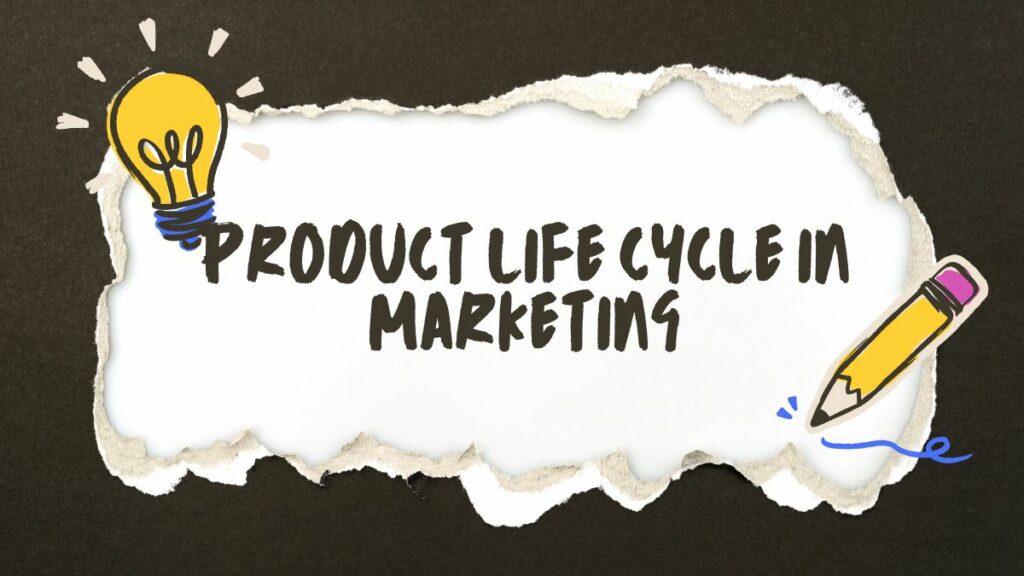Last updated on September 25th, 2024 at 10:14 am
Have you ever wondered why some products seem to explode in popularity only to fade away a few years later, while others maintain a steady presence for decades? The answer lies in the product life cycle, a fundamental concept in marketing.
The product life cycle in marketing is a framework that maps the journey of a product from its initial introduction to its eventual decline. By understanding the distinct stages of the product life cycle, marketers can develop targeted strategies to maximise success at each point. Let us learn more about the product life cycle and its 4 stages with marketing suggestions and examples.
The 4 Stages of Product Life Cycle in Marketing
The product life cycle in marketing is typically divided into four key stages. Understanding these stages is crucial for developing effective marketing strategies. A one-size-fits-all approach won't work. By aligning your marketing efforts with the specific needs of each stage, you can ensure your product reaches its full potential and achieves long-term success.
These product life cycle stages are:
- Introduction: This is the launch phase, where the product is introduced to the market and consumers are just becoming aware of it.
- Growth: This stage sees rapid sales growth and increased brand recognition as the product gains wider acceptance.
- Maturity: The market becomes saturated, and sales stabilise or slow down. Competition intensifies, and marketers need to work harder to maintain market share.
- Decline: Sales begin to fall as the product becomes outdated or faces superior alternatives. This is the stage where marketers may need to consider phasing out the product or finding ways to revitalise it.
Now that we know “what is product life cycle in marketing”, let us learn about these stages in more detail.
Stage 1: The Introduction Stage
Launching a new product is an exciting yet challenging endeavour. The introduction stage is all about creating awareness, sparking interest, and convincing consumers to take a chance on your offering. Here is where a well-defined marketing strategy becomes critical to overcome these challenges:
1. Product Development and Competitive Pricing
Before igniting the spark, ensure your product itself is the spark. Invest in thorough development and testing to deliver a high-quality product that meets a genuine consumer need. Additionally, establish a competitive price point that balances profitability with attracting early adopters. Don't be afraid to offer introductory discounts or special offers to incentivise initial purchases.
2. Public Relations and Influencer Marketing
In a crowded marketplace, generating buzz is essential. Public relations efforts can get your product featured in relevant media outlets, reaching a wider audience and establishing credibility. Influencer marketing can be a powerful tool, partnering with industry experts or social media personalities who can endorse your product to their engaged followers.
3. Content Marketing and Social Media Engagement
Compelling content is king. Create informative and engaging blog posts, articles, or social media content that educates potential customers about your product's benefits and unique selling points (USPs). Utilise social media platforms to connect with your target audience, fostering conversation and building excitement around your product launch.
4. Early Adopter Targeting: Embrace the Feedback Loop
Early adopters are the trailblazers who embrace new products. Identify and target these trendsetters who are eager to try innovative solutions. Early adopters can provide valuable feedback that helps refine your product and messaging before a wider rollout. By offering exclusive access or early-bird discounts, you can incentivise them to be part of your launch journey.
Stage 2: The Growth Stage
The growth stage is where your product's popularity takes off. Sales soar, brand recognition surges and the market welcomes your offering with open arms. But don't get complacent! This is the time to capitalise on the momentum and solidify your product's position in the market. Here are key marketing strategies to ride the growth wave:
1. Performance Marketing and Paid Advertising
Expand your reach beyond early adopters by leveraging paid advertising channels. Search engine marketing (SEM) positions your product at the top of relevant search results, while social media advertising allows you to target specific demographics and interests with laser focus. Paid advertising empowers you to capture a wider audience and drive targeted traffic to your website or landing pages.
2. Customer Acquisition and Retention Go Hand in Hand
While acquiring new customers is essential, retaining existing ones is crucial for long-term success. Implement loyalty programs to reward repeat customers and incentivise continued engagement. Personalised marketing strategies, like targeted email campaigns or product recommendations, foster deeper connections with your customer base. Prioritise customer satisfaction by providing excellent customer service and addressing any issues promptly.
3. Product Differentiation and Building a Strong Brand Identity
The market is likely to see competitors emerge during the growth stage. Stand out from the crowd and clearly communicate your product's unique selling points (USPs) and the value proposition it offers to consumers. Build a strong brand identity that resonates with your target audience. This could involve developing a consistent brand voice and visual identity across all marketing materials and touchpoints. A strong brand not only attracts customers but also fosters brand loyalty.
By effectively implementing these strategies, you can capitalise on the growth stage, maximise sales, and establish your product as a leader in the market. Remember, the growth stage of the product life cycle in marketing is all about scaling your marketing efforts while nurturing your customer base.
Stage 3: The Maturity Stage
The maturity stage brings a different set of challenges. Competition intensifies as the market becomes saturated with similar products. Sales start to stabilise or even decline slightly. While the initial excitement might have faded, the maturity stage offers valuable opportunities to optimise your product's position and ensure long-term success.
1. Product Innovation and Line Extensions
Stagnation breeds decline. To stay ahead of the curve, continuous product innovation becomes critical. Invest in research and development to improve your core product or explore innovative features that enhance functionality and user experience. Additionally, consider line extensions that cater to different market segments or price points. This allows you to capture new customer segments and maintain market share.
2. Customer Loyalty is Your Golden Ticket
Existing customers are your most valuable asset in the maturity stage. Implement strategies to cultivate customer loyalty and encourage repeat business. Loyalty programs reward frequent customers and incentivise continued engagement. Upselling and cross-selling techniques can encourage customers to purchase higher-tier versions of your product or related offerings, increasing average order value.
3. Data-driven Marketing for Smarter Decisions
Leverage the power of customer data to optimise your marketing efforts in the maturity stage. Analyse customer behaviour and preferences to personalise your marketing messages and target campaigns more effectively. A/B testing allows you to compare different marketing approaches and identify the strategies that resonate best with your audience. Utilise data-driven insights to maximise marketing ROI and refine your strategies for continuous improvement.
By focusing on product innovation, nurturing customer loyalty, and implementing data-driven marketing strategies, you can navigate the maturity stage of the product life cycle in marketing effectively. Remember, the goal is to optimise your product's presence and establish a long-term advantage in a competitive market.
Stage 4: The Decline Stage
The decline stage is inevitable for all products. Sales fall, competition intensifies further, and the product becomes less profitable. While it might be tempting to ignore the decline, a strategic approach can still be beneficial. Here are some strategies to navigate this final phase gracefully:
1. Cost Optimisation and Strategic Resource Allocation
As sales decline, cost optimisation becomes crucial. Analyse production and marketing expenses, identify areas for cost reduction, and streamline operations where possible. Strategically allocate remaining resources towards promoting more profitable products or exploring new ventures.
2. Harvesting Revenue and Phasing Out with Dignity
The goal here is to maximise remaining revenue while gracefully phasing out the product. Offering price reductions or bundling the product with other offerings can entice customers to make final purchases. Communicate the product's end-of-life cycle transparently to manage customer expectations. Consider offering extended warranties or support for a limited time to maintain a positive brand image.
3. Brand Repositioning or a Revamped Future?
In some cases, depending on the brand and product, there might be opportunities to breathe new life into the product. Consider brand repositioning strategies that target a different market segment or reframe the product's value proposition. If the core concept still holds merit, explore the possibility of a complete revamp with significant upgrades or innovative features.
Remember, the decline stage of the product life cycle in marketing is not necessarily the end of the story. By implementing these strategies, you can minimise losses, manage the product's exit effectively, and even create opportunities for future success. The knowledge gained from the product's journey can be invaluable in developing new and innovative offerings for your brand.
Product Life Cycle Stages Examples
We have already covered what is product life cycle and its four different stages. Let us now look at product life cycle stages examples to understand product life cycle in marketing more effectively.
Introduction Stage
Product: Virtual Reality (VR) Headsets
Challenges: Generating awareness for this new technology, educating consumers about potential uses and overcoming initial price barriers.
Marketing Strategies:
- Public relations campaigns showcasing VR's potential in gaming, education, and healthcare.
- Influencer marketing with tech reviewers and gamers to generate buzz.
- Content marketing explaining the benefits and functionalities of VR headsets.
Growth Stage
Product: Smartphones (early 2010s)
Characteristics: Rapid sales growth as consumers embraced the convenience and functionalities of smartphones. Increased competition from various brands offering different features and price points.
Marketing Strategies:
- Performance marketing campaigns (search engine marketing and social media advertising) to target specific demographics interested in features like mobile browsing, email access, and app downloads.
- Focus on brand differentiation by highlighting unique features like camera quality, battery life, or app ecosystem.
Maturity Stage
Product: Personal Computers (PCs)
Characteristics: The PC market has reached maturity, with established brands offering a wide range of products for different needs. Sales have stabilised, and competition focuses on innovation and differentiation.
Marketing Strategies:
- Customer loyalty programs rewarding repeat customers with upgrades or discounts.
- Upselling strategies promoting high-performance PCs for gaming or professional use.
- Data-driven marketing to personalise marketing messages and target campaigns based on customer preferences.
Decline Stage
Product: Floppy Disks
Challenges: Technological advancements rendered floppy disks obsolete with the rise of USB drives and cloud storage.
Marketing Strategies (limited applicability in this stage):
- Price reductions to clear remaining stock.
- Bundling floppy drives with other products (e.g., used computers) to incentivise purchase.
Wrapping Up
The product life cycle in marketing is a fundamental concept that equips marketers with a roadmap for success. Understanding the distinct stages of this life cycle allows you to tailor your marketing efforts to maximise impact at each point in a product's journey.
By embracing the product life cycle and adapting your marketing strategies accordingly, you can ensure your products not only achieve initial success but also thrive in the long run. The knowledge gained from each stage informs future endeavours, paving the way for continuous innovation and lasting brand success.
If you wish to become a chief marketing officer, you can enrol in the IIM Lucknow Chief Marketing Officer Program. This 6-month program is offered by Imarticus Learning in collaboration with IIM Lucknow to help senior leaders ascend to the chief marketing officer role.
Frequently Asked Questions
Q: My product is in the introduction stage of the product life cycle. How can I generate buzz and create awareness?
During the introduction stage of the product life cycle in marketing, creating awareness and sparking consumer interest is crucial. Here are some marketing strategies:
- Partner with media outlets and relevant influencers to generate buzz and get your product featured in reviews or social media posts.
- Develop engaging blog posts, articles, or social media content that educates potential customers about your product's benefits and unique selling points (USPs).
- Identify and target trendsetters and early adopters who are eager to try new products. Offer them exclusive access or early-bird discounts to incentivise them to be part of your launch journey.
Q: My product is experiencing rapid growth. How can I expand my reach and maintain momentum?
The growth stage of the product life cycle in marketing is your time to capitalise on rising sales and brand recognition. Here are some marketing strategies:
- Utilise paid advertising channels like search engine marketing (SEM) and social media advertising to target specific demographics and expand your reach beyond early adopters.
- Implement customer acquisition strategies alongside strategies to retain existing customers. Loyalty programs reward repeat customers, while personalised marketing fosters deeper connections. Excellent customer service builds trust and encourages continued engagement.
- Clearly communicate your product's USPs and how it solves customer problems. Develop a strong brand identity that resonates with your target audience, establishing a consistent voice and visual identity across all marketing materials.
Q: The market for my product seems saturated. How can I stay relevant in the maturity stage of the product life cycle?
The maturity stage of the product life cycle in marketing requires strategic marketing to maintain market share and profitability. Here are some strategies:
- Invest in research and development to improve your core product or explore innovative features. Consider line extensions that cater to different market segments or price points, keeping your offering fresh and attractive to new customer groups.
- Prioritise retaining existing customers. Loyalty programs reward repeat business while upselling and cross-selling techniques encourage customers to invest further in your product ecosystem.
- Leverage customer data to personalise marketing messages and target campaigns more effectively. Utilise A/B testing to optimise marketing strategies and maximise ROI.
Q: Sales for my product are declining. What are some strategies for navigating the decline stage of the product life cycle?
The decline stage of the product life cycle in marketing requires a strategic approach to minimise losses and manage the product's exit gracefully. Here are some strategies:
- Analyse production and marketing expenses. Identify areas for cost reduction and streamline operations to maintain profitability for as long as possible.
- Offer price reductions or bundle the product with other offerings to maximise remaining revenue. Communicate the product's end-of-life cycle transparently and manage customer expectations. Consider extended warranties or support for a limited time to maintain a positive brand image.
- In some cases, explore brand repositioning strategies that target a different market segment or reframe the product's value proposition.
By understanding the product life cycle and implementing these targeted marketing strategies at each stage, you can maximise your product's success and ensure its long-term viability in a competitive market.








